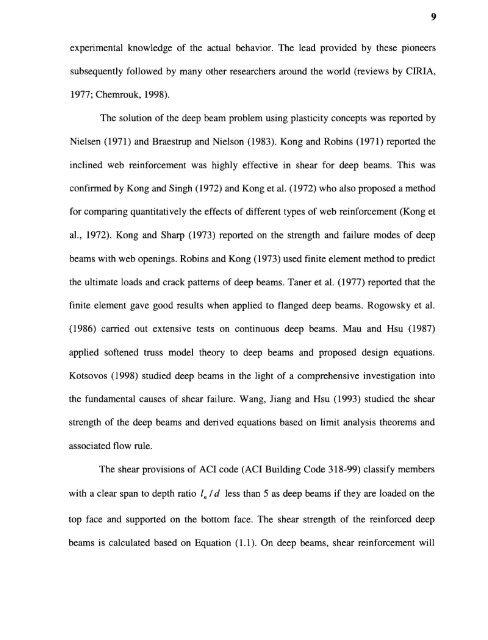njit-etd2003-032 - New Jersey Institute of Technology
njit-etd2003-032 - New Jersey Institute of Technology
njit-etd2003-032 - New Jersey Institute of Technology
You also want an ePaper? Increase the reach of your titles
YUMPU automatically turns print PDFs into web optimized ePapers that Google loves.
9<br />
experimental knowledge <strong>of</strong> the actual behavior. The lead provided by these pioneers<br />
subsequently followed by many other researchers around the world (reviews by C1R1A,<br />
1977; Chemrouk, 1998).<br />
The solution <strong>of</strong> the deep beam problem using plasticity concepts was reported by<br />
Nielsen (1971) and Braestrup and Nielson (1983). Kong and Robins (1971) reported the<br />
inclined web reinforcement was highly effective in shear for deep beams. This was<br />
confirmed by Kong and Singh (1972) and Kong et al. (1972) who also proposed a method<br />
for comparing quantitatively the effects <strong>of</strong> different types <strong>of</strong> web reinforcement (Kong et<br />
al., 1972). Kong and Sharp (1973) reported on the strength and failure modes <strong>of</strong> deep<br />
beams with web openings. Robins and Kong (1973) used finite element method to predict<br />
the ultimate loads and crack patterns <strong>of</strong> deep beams. Taner et al. (1977) reported that the<br />
finite element gave good results when applied to flanged deep beams. Rogowsky et al.<br />
(1986) carried out extensive tests on continuous deep beams. Mau and Hsu (1987)<br />
applied s<strong>of</strong>tened truss model theory to deep beams and proposed design equations.<br />
Kotsovos (1998) studied deep beams in the light <strong>of</strong> a comprehensive investigation into<br />
the fundamental causes <strong>of</strong> shear failure. Wang, Jiang and Hsu (1993) studied the shear<br />
strength <strong>of</strong> the deep beams and derived equations based on limit analysis theorems and<br />
associated flow rule.<br />
The shear provisions <strong>of</strong> AC1 code (AC1 Building Code 318-99) classify members<br />
with a clear span to depth ratio 1,, i d less than 5 as deep beams if they are loaded on the<br />
top face and supported on the bottom face. The shear strength <strong>of</strong> the reinforced deep<br />
beams is calculated based on Equation (1.1). On deep beams, shear reinforcement will

















